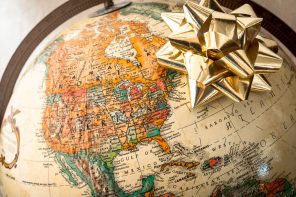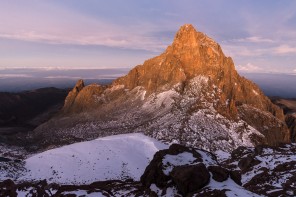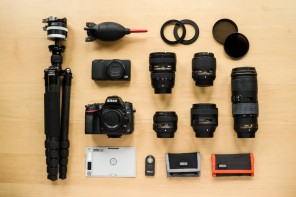I don’t pack “light”. I gave up on that a long time ago. I now pack for the greatest amount of flexibility and enjoyment possible while traveling internationally.
After ten years of independent, self-guided and self-executed travel, I have a fairly clear idea of what I need to cram in my backpack and day bag for a healthy mix of photography, blogging, hiking, beach-bumming, public-transit-riding, outright wandering/adventuring and sometimes even things like scuba diving and winter sports.
Yes, it’s often possible to pack for pretty much all of these activities at once. No, you won’t have the lightest pack in the world, but you’ll have everything you need.
My style of travel dictates my packing list:
- I pack in order to be flexible/versatile on the road, but not so much as to encumber myself unnecessarily – thus, I must fit every bit of my travel kit into (1) full-size internal frame backpack and (1) day bag. I will only allow myself one checked bag per flight, and will keep the weight of my backpack and day bag to levels that I feel comfortable carrying each day without discomfort nor pain.
- I am a BUDGET traveler, seeking the best value and most enjoyment for my money. Accordingly, I will need to be somewhat self-reliant.
- One should pack more or less the same for a ten-day trip as one does for a three-month trip.
- My travels will take me to both major cities and rural places of natural beauty; subtropical regions and locales with temperatures that fall below freezing. I may find myself spending time with urbane, well-dressed people, but also on dusty roadsides in poor communities. I should pack clothing and footwear that keeps these dualities in mind.
- I will find myself transported by airplane, train, metro, boat, taxi, autorickshaw, sometimes camel.
- I will rent a room/bed in the majority of my destinations (in other words, my list does NOT necessarily fully cover you for camping/trekking, much less mountaineering). Sometimes these rented rooms/beds will be in shared rooms in guesthouses and hostels.
- I will not be doing heavy amounts of computer-based work on the road, but need to shoot high quality pictures and write/post blog entries, so I need to be equipped accordingly.
- I don’t plan on carrying home a bunch of souvenirs. If I buy stuff, I’ll keep it small, or try to ship it home.
Below is the way I begin packing for basically ANY independent trip, tweaked appropriately for weather and activities I know I’ll be doing along the way.
INTERNAL FRAME BACKPACK
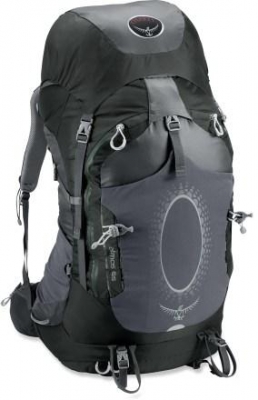
Osprey Atmos 65 internal frame backpack.
I carry an internal frame backpack for hauling most of my luggage for my travels.
My primary backpack as of 2013/2014 is the Osprey Atmos 65, a lightweight 65-liter internal frame pack. Osprey is a great brand, but I also recommend manufacturers like Gregory, Lowe Alpine and Arc’Teryx. Kelty also makes quality packs that are sometimes slightly less expensive.
Note: I do NOT recommend traveling with an old military surplus backpack. If you’re military personnel and you’re used to this type of baggage, proceed as you like – but for the average traveler, a modern internal frame pack is going to be much more comfortable and much easier to use.
When fully loaded for multi-month trips, my pack usually hits around 30-35 lbs (13-16 kg) total. Many travelers use smaller 40-50L packs and carry less, and are no less happy for it. Smaller is almost always better if you can swing it!
I use the following to keep my backpack internally organized:
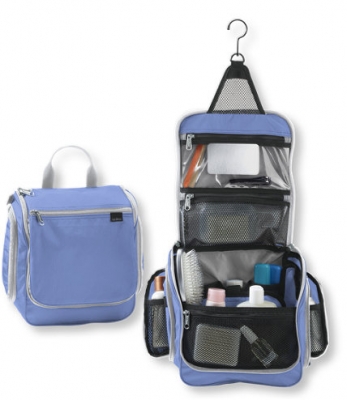
LL Bean Personal Organizer Toiletry Bag.
- (1-2) Eagle Creek compression bags – medium (or similar) – used for compressing clothing into a more manageable size for transit.
- (1-2) Eagle Creek half-size split packing cube (or similar) – more organization for your bag.
- (1) LL Bean Personal Organizer Toiletry bag (or similar). I can’t recommend a hanging toiletry bag enough, as almost nowhere I go has any usable bathroom counter space to speak of. Being able to hang up my toiletries in any bathroom is a simple convenience that I almost can’t do without anymore. Other travelers tell me the same.
- (1) Think Tank Photo “My 2nd Brain Powerhouse Pro” zipper pouch for organizing computer chargers, cables and hard drives. This pouch has just a little more structure than the Eagle Creek organizers which makes it a slightly safer place to store and organize my electronics peripherals.
I always hang two colorful luggage tags on the outside of my bag for easy reference by baggage handlers. If one tag falls off, one remains.
DAY PACK
My day bag almost never leaves my side on my travels (I often can be found clutching it on trains and in hostel dorm beds), and I’m in and out of it hundreds-to-thousands of times per trip, so it’s gotta be the RIGHT bag for the trip and for what it will contain. Nothing is more irritating than carrying a bag that just doesn’t work for you.
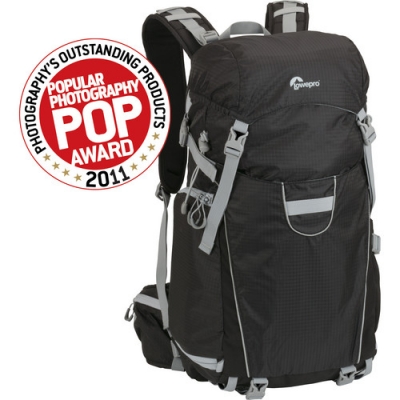
the LowePro Photo Sport AW 200 is my usual day pack as of 2014/2015.
On any given day, my day bag will contain a DSLR camera with 2-3 lenses, a water bottle, sunglasses, travel guidebook, maybe a rain jacket, and often snacks to get me through periods of transit or boredom. This usually weighs in at about 10-12 lbs (around 5 kg) which often feels like 100 lbs by the end of a long day.
I prefer that my day bag be somewhat inconspicuous (e.g. NOT something that immediately looks like a camera bag), low profile enough to allow me to ride crowded mass transit without too much trouble spatially or from potential thieves, allow for fairly quick access to my camera and lenses, and be at least somewhat weather resistant in case of rain.
After what felt like an ENDLESS search online and at camera shops, I have arrived at two favorite day bags for travel. I carry one or the other on each international trip:
- SMALLISH BACKPACK OPTION: Lowepro Photo Sport 200 AW Backpack
- SHOULDER BAG OPTION: Domke J-803 Digital Satchel
Day pack choice and camera gear choices are inextricably linked ideas. For a list of my current camera gear list for travel, click through.
IDENTIFICATION, CREDIT CARDS & MONEY
IDENTIFICATION
- US Passport (current, with at least two blank/available visa pages and at least six months of validity remaining, but one year of remaining validity preferred)
- An additional form of picture ID (Drivers License, etc)
- Printed copies of any/all required foreign visas needed for entry/exit to destination countries
- International Driving Permit (if applicable)
- Printed travel insurance card
- Health insurance card from home country
- Auto insurance card from home country
- Immunization records (talk to your doctor or travel health clinic prior to departure – you may need to get vaccinated for things like Hepatitis A, Typhoid, Yellow Fever, etc. Further, the Yellow Fever vaccine is required for entry into certain countries – check the CDC’s website for destination-specific information.)
- SCUBA diving certification card (PADI in my case, perhaps SSI or others in yours)
- (6-10) recent passport-sized photos in case foreign visas must be issued during travel
- (6-10) black/white photocopies of passport picture page in case foreign visas must be issued during travel, or hotel front desks require photocopy of passport
- (1) black/white photocopy of all credit cards and ID, hidden in backpack
- (1) USB flash drive containing scans of passport, credit cards, other documents (carry USB drive on keychain)
BANK CARDS & CREDIT CARDS
- (2) ATM cards linked to different major banks. This way if one is compromised, lost or stolen, I still have access to cash via the other card/bank.
- (2) credit cards linked to major banks. Visa or Mastercard credit cards with Chip and PIN technology are preferred and most widely accepted. Note that American Express and DISCOVER are often not accepted outside the US.
RELATED POST: Credit Cards & ATM Cards That I Use for Travel
RELATED POST: Travel Tips: Never Run Out of Cash While Traveling
FOR CARRYING CASH & IDENTIFICATION
- Standard wallet for most purposes, carried in my front pocket for most periods of travel so as to avoid pickpocketing. Knock on wood, I have not yet had my wallet stolen on a trip (though I have definitely LOST my wallet before!).
- Concealable money belt for carriage of cash/passport and other identification during transit periods. I don’t wear this all day every day, but I always have it with me in my pack for each trip, and regularly put it on when I’m in transit with all my belongings – especially on crowded public transport.
CASH
- I generally carry around $100-400 cash in US Dollars or Euros to start my trip. I hide $50.00 of this somewhere in my journal or toiletry bag as an emergency cash reserve.
NOTABLE OMISSION
- Travelers checks are useless in this day and age. Don’t bother.
TOILETRIES / HEALTH
EYEWEAR
- Sunglasses + case
- Contact Lenses + cleaning case (bring more than you think you’ll need – it can be difficult to replace these on the road)
- Prescription eyeglasses + case (if you wear glasses daily, bring a backup pair for a total of two pairs of glasses)
TOILETRIES – LIQUIDS & GELS
- Contact Lens Solution (please note that contact lens solution may be outright unavailable or extremely expensive in developing countries. Even in places like Mexico and Guatemala, contact lens solution can be hard to find, and you can expect to pay high prices for small amounts of it. Pack plenty of contact solution if you wear contacts.).
- Shampoo (2-3 ounce bottle). I don’t carry conditioner, but if you need it, go ahead. Dry shampoo is also worth your consideration, though I haven’t used it myself.
- Toothpaste (2-3 ounces)
- Small bottle hand/face lotion (1-2 ounces)
- Sunscreen (1-2 ounce travel bottle generally, or full size bottle for beach/desert travel). Note that sunscreen/sunblock can be expensive and/or very hard to find in less-developed countries.
- Small bottle of heavy-duty insect repellent (2-4 ounces, usually 30-100% DEET. You will not be able to buy this in developing countries, or even jungle-y places you’d expect to find heavy duty repellent (like Peru) – so buy it at home.
- Small bottle of hand sanitizer (2 ounces)
- Small bottle of concentrated laundry detergent (2 ounces) – for washing your nasty dirty clothes in the sink.
TOILETRIES – NON-LIQUID
- Microfiber pack towel – large or XL size (Towels are not provided at many budget lodgings. Also, these dry more quickly and pack smaller than conventional towels.).
- Basic bar of soap (carry in a basic soap case like this one).
- Toothbrush
- Dental floss
- A couple of cigarette lighters (BIC brand preferred – from my experience, they work best!)
- Gold Bond (or equivalent) medicated powder – great for humid climates and resultant chafing
- Lip balm / Chapstick
- Comb or hair brush
- Rechargeable electric razor + wall charger (almost all are dual-voltage, so no voltage adaptor is required). Alternatively: disposable razors – no power required at all!
- Tweezers
- Fingernail clippers
- Earplugs (for airplanes or particularly noisy sleeping arrangements)
- Small sewing kit for reattaching buttons, etc.
- Condoms / birth control as applicable (both potentially unavailable in the countries you visit – so bring plenty)
- Feminine hygiene products (as applicable)
MEDICATION/FIRST AID
- Assorted self-adhesive bandages
- Small tube of antibiotic ointment
- Small tube of hydrocortisone anti-itch cream (especially useful to help keep you from scratching insect bites / rashes into potentially dangerous infections)
- Ibuprofen and/or Naproxen pills for pain relief
- Melatonin tablets (non-prescription sleep aid)
- Chewable antacids or pill-form antacids
- Nyquil / Dayquil caplets (or generic equivalent)
- Anti-diarrhea pills (generic over-the-counter variety like Imodium is fine)
- Oral rehydration salts (for rehydrating during/after travelers diarrhea)
- Azithromycin or Ciprofloxacin – for more serious bacterial diarrhea problems. These require a prescription – talk to your doctor or travel health clinic.
- AS NEEDED: specific additional medications like malaria prophylaxis (prevention) medication. Talk to your doctor or a travel medicine clinic like the Visiting Nurse Association or Passport Health and discuss the countries you’ll be visiting prior to departure.
FOOTWEAR
- (1 pair) high quality walking/hiking boots or shoes, preferably waterproof/gore tex. My personal preference: Ecco brand.
- (1 pair) good quality hiking sandals. My preference: Chacos brand. I use these as my shower shoes as well, so no need to bring an additional pair of flip-flops.
- (1 pair) lightweight casual shoes for wear around town. Or, trade these for running/training shoes if you expect to be exercising a lot on your trip.
CLOTHING
CLOTHING FOR WARM / TEMPERATE WEATHER TRAVEL
- (3-4) t-shirts
- (1-2) button down shirts – light fabrics in colors/patterns that don’t easily show dirt
- (1) tank top (or just buy this on your trip)
- (1) high quality fleece or wool sweater (100% Merino wool is my preference)
- (1 pair) swimsuit or board shorts
- (1-2 pair) shorts
- (2 pair) long pants. I generally limit myself to ONE pair of jeans – though they’re durable and comfortable, they’re heavy and they don’t dry easily in humid climates.
- (5-6 pairs) socks – Merino wool preferred over cotton
- (3-4 pairs) underwear
- (1) pair lightweight gloves
- (1) lightweight waterproof rain shell (can be turned into a warm/waterproof setup with the sweater layered underneath)
- (1) hat for shade from sun (these can almost always be bought cheap on the road if you forget)
- (2) bandanas, for as many purposes as you can dream up
- Optional: (1) scarf / shawl – very useful for women traveling in developing/conservative countries for required cover-ups as well as sun protection
COLD WEATHER CLOTHING – ADDITIONS / CHANGES TO THE ABOVE
- (1) winter hat (carry this instead of above sun-shade hat)
- (1) scarf or neck gaiter
- (1 pair) long underwear bottoms
- (1 pair) long underwear top
- (1 pair) cold weather gloves (waterproof, if bad weather or winter sports are anticipated)
CAMERA GEAR
- I generally travel with a full frame DSLR, three lenses, maybe a compact camera, and associated accessories. See my Photo Gear List for Travel for further details.
PHONE & MUSIC DEVICES
- WiFi-capable smartphone, unlocked from its initial carrier (AT&T in my case) for international usage. As of October 2015, I use an 32GB iPhone 5s for this purpose.
- Two charging cables for above smartphone (one is a backup)
- External USB-Rechargeable battery for recharging smartphone (comes in handy on long flights. Example: Anker Astro Mini 3000mAh Ultra-Compact Portable Charger
- Earbuds. I bring two pairs because I misplace, lose or destroy them frequently. I like the proprietary Apple earbuds with remote and mic, but to each their own.
- Rechargeable USB speaker like the JBL Clip or iHome iHM60. This gets used almost every day for listening to music in the room or with new travel buddies. The JBL Clip is Bluetooth friendly and puts out really fantastic sound for its size – the only caveat is that the battery only lasts for around 5 hours.
COMPUTER
Note: not everyone needs to carry a computer for their for-pleasure travel.
Shared computers at guesthouses, internet cafes and hostels are sufficient resources for most. If you’re not shooting a ton of pictures or trying to keep up with a blog or work on the fly, then there’s really no reason to carry an additional piece of gear that could easily be stolen or broken. Carrying more possessions – especially expensive ones – just means more worry, liability and baggage management.
However, if you have specific needs like heavy blogging/journaling, backing up a ton of photos or video, or keeping up with work e-mails while out and about, you may be a candidate for bringing a computer on the road.
My first travel computer was a cheap MS Windows-based netbook ($300 purchase price in 2011), but I came to hate its buggy operating system and its crippled abilities that I eventually purchased a MacBook Air 11″, which does almost everything I could ask for while traveling – all in a thin and lightweight package that I don’t mind carrying along.
The MacBook Air 11″ (2013 model)’s size and weight:
Height: 0.11-0.68 inch (0.3-1.7 cm)
Width: 11.8 inches (30 cm)
Depth: 7.56 inches (19.2 cm)
Weight: 2.38 pounds (1.08 kg)
I work from the Apple platform at home, so use of a MacBook Air on the road means I can use previously purchased licenses of Microsoft Office, Adobe Photoshop Lightroom & Adobe Creative Suite and other critical pieces of software without having to repurchase them for another operating system. It’s pretty great, and helps me rationalize the additional cost of owning a MacBook Air vs. a cheaper netbook PC.
Could I carry just an iPad or equivalent tablet instead of a MacBook Air?
For my purposes, no. If I’m writing on the road, I need a proper keyboard and touchpad, and for photo management, I want more onboard storage space as well as the connectivity of an actual computer (USB 3.0, Thunderbolt, etc). There are workarounds for this on the iPad, but they’re still.. just.. workarounds.
So, here’s what I carry, computer-wise, as of 2014:
- SMALL LIGHTWEIGHT LAPTOP: Apple MacBook Air 11″ (2013 model, 256gb SSD, 4GB RAM) + power adaptor.
- ETHERNET ADAPTER FOR MACBOOK AIR: Thunderbolt to Gigabit Ethernet Adapter – because reliable Wi-Fi isn’t guaranteed on the road, and sometimes a hardwired connection is your best bet.
- (2) EXTERNAL HARD DRIVES: USB 3.0-capable, bus powered (no additional power cable) hard drive. Both are 1TB in size – one is a master drive, the other is a copy of the first.
- CARD READER: small USB 3.0 card reader
- USB HUB: small USB 3.0 hub (the MacBook Air only has two USB ports – I regularly need more than this)
- a couple of additional USB flash drives for sharing pictures with friends on the road, file transfers, etc.
Note: technology and photography items may be difficult to replace in many countries, so one should be diligent not to lose any necessary cabling, adapters and other accessories for one’s camera, phone and computer. Proper organization is key.
BOOKS
- TRAVEL GUIDEBOOK: country-specific or region-specific guidebook as applicable, from publishers like Rough Guides or Lonely Planet, or Bradt.
- E-BOOK: Kindle + USB-to-micro USB cable for charging (or equivalent like the Nook, iPad mini, etc). Sometimes I carry a paperback as well, but more often than not I read for pleasure on my Kindle nowadays.
- NOTEBOOK: Small paper notebook / notepad for misc notes or journaling.
- DIVING LOG BOOK for SCUBA diving (if diving is expected on trip)
MISCELLANEOUS GADGETRY
CRITICAL GADGETS
- Waterproof covers for primary backpack and daypack (a trash bag can work in a pinch)
- An LED headlamp.
- Universal electrical plug adaptor like the Universal plug adaptor (by Kikkerland), or just a simple set of plug adapters from REI. My experience is that simple plug adapters are better than complicated bulky ones that look like Swiss Army knives of plug types – the big ones tend to fall out of outlets due to their weight, and are often, accordingly, completely useless. Note that the Kikkerland adapter will NOT work for travel in England.
- Travel-size power outlet, with 3-4 outlets. This means you can simultaneously charge multiple items in areas where outlets can sometimes be exceedingly scarce – like airports and hostel dorm rooms.
- Retractable cable lock (thin steel retractable cable for chaining your backpack up on overnight buses/trains.)
- A basic rotary combination lock with metal hasp. Use this for lockers in your hostel.
- Pen knife (no need for anything larger than a 1.5″ long blade, generally)
- Travel spork, for when silverware isn’t available
- Zip-loc plastic bags of various sizes (sandwich, quart, gallon, two-gallon. Very, very useful for a wide array of purposes).
- Dry bag (super lightweight, ultra-sil dry bag – I prefer something around a 4-8 liter size. This can be used for quickly waterproofing electronics in rain or on boats).
- 20-30 ft. of nylon utility cord for use as a clothesline.
- A couple of pens and permanent markers.
OPTIONAL GADGETS THAT I REGULARLY CARRY
- A filtration water bottle, like this or this from ClearlyFiltered. Use these to filter otherwise undrinkable tap water as well as other fresh water sources like streams. These bottles are a great way to save on costs of bottled water, and reduce the amount of plastic bottle waste you generate on a trip. I used a ClearlyFiltered bottle in Central America for over six months in 2014 and now consider water filtration bottles indispensable for travel.
- Small keychain compass. Great for orienting yourself to new cities when you first get off the bus/train.
- Flashlight – key chain size. You may be able to get by with just a headlamp, but I often find myself in the dark while traveling, and an additional flashlight on my keychain or stashed in my toiletries bag comes into play often. I prefer these to take standard AA or AAA batteries, because more specialized batteries like CR123A size can be harder to find on the road.
- A silk sleep sheet. I often carry the Cocoon brand silk sleep sheet, though I admittedly rarely use it.
- Hydration Bladder. A hydration bladder may or may not be useful to you depending on your backpack and/or daypack type – but if you’re planning on doing any trekking on your trip, this is a great thing to have for convenient access to drinking water. I use a 2-Liter Camelbak “Antidote” reservoir at present.
- A few binder clips and/or clothespins, a few zip-ties, a few rubber bands, scotch tape, maybe a bit of gaffer’s tape – miscellaneous use.
OPTIONAL / SITUATIONAL GADGETS
- Personal scuba diving mask (and possibly a personal snorkel). I’ve found that rental gear from diving outfitters can really vary in quality, so carrying a personal mask from home can be a boon to your comfort, visibility and overall enjoyment when underwater. Of course, carrying a snorkel when you’re far inland looks completely ridiculous, but who cares.
- Mosquito net / mosquito tent. You may or may not need to carry your own mosquito net for trips to various tropical areas. Research your destination(s) accordingly. I find that USUALLY you can get away with NOT bringing one.
- Small digital luggage scale. If you’re regularly pushing it on airline baggage weight restrictions, you should definitely consider bringing along one of these.
NOTABLY OMITTED GADGETS
- Sleeping bag, sleeping pad, pillow. If you’re going to be doing a lot of camping/trekking, you might consider bringing these. If camping/trekking are only a small part of your trip, you should consider buying or renting them along the way. If I do carry a sleeping bag and sleeping pad, it’s the Feathered Friends Osprey UL Down Sleeping Bag (standard size), and the Therm-A-Rest NeoAir (large size), as they are some of the lightest weight and most packable solutions I’ve found (though prices are admittedly high in comparison to other similar products). For sizing: I’m 5’10” tall (178 cm).
- Electrical voltage adaptor. These things are super heavy, and most electrical devices you’ll be carrying don’t require them. If you want to use a hair dryer in the country you’re visiting, just buy a hair dryer when you get there – that way it’s automatically paired with the electric current standards of said country.
- Travel Hammock. Not worth the added weight to your pack. Buy cheap hammocks along the way instead.
- Laundry bag – use plastic bags instead.
IN REVIEW: THINGS NOT TO FORGET
Most of the above clothing items and gadgetry can be either done without or sourced in some way while traveling. But remember, these potentially critical items have been the most impossible, annoying and/or expensive items to source while traveling, especially in developing countries, so don’t necessarily assume you can find the following while you’re out in parts unknown:
- Effective insect repellent (30-100% DEET)
- Condoms
- Birth Control of any type
- Malaria prevention drugs
- Contact lenses
- Contact lens solution
- Sunscreen
- Prescription drugs like Azithromycin or Ciprofloxacin for serious travelers diarrhea
- Any other prescriptions you regularly take
Thanks for reading/referencing! Considering my luck, I imagine that half the hyperlinks on this page will be dead within six months – feel free to notify me if one is down, or if you have any questions about my experiences with certain products.
Note: I am not paid by any of the companies/products I reference above.


